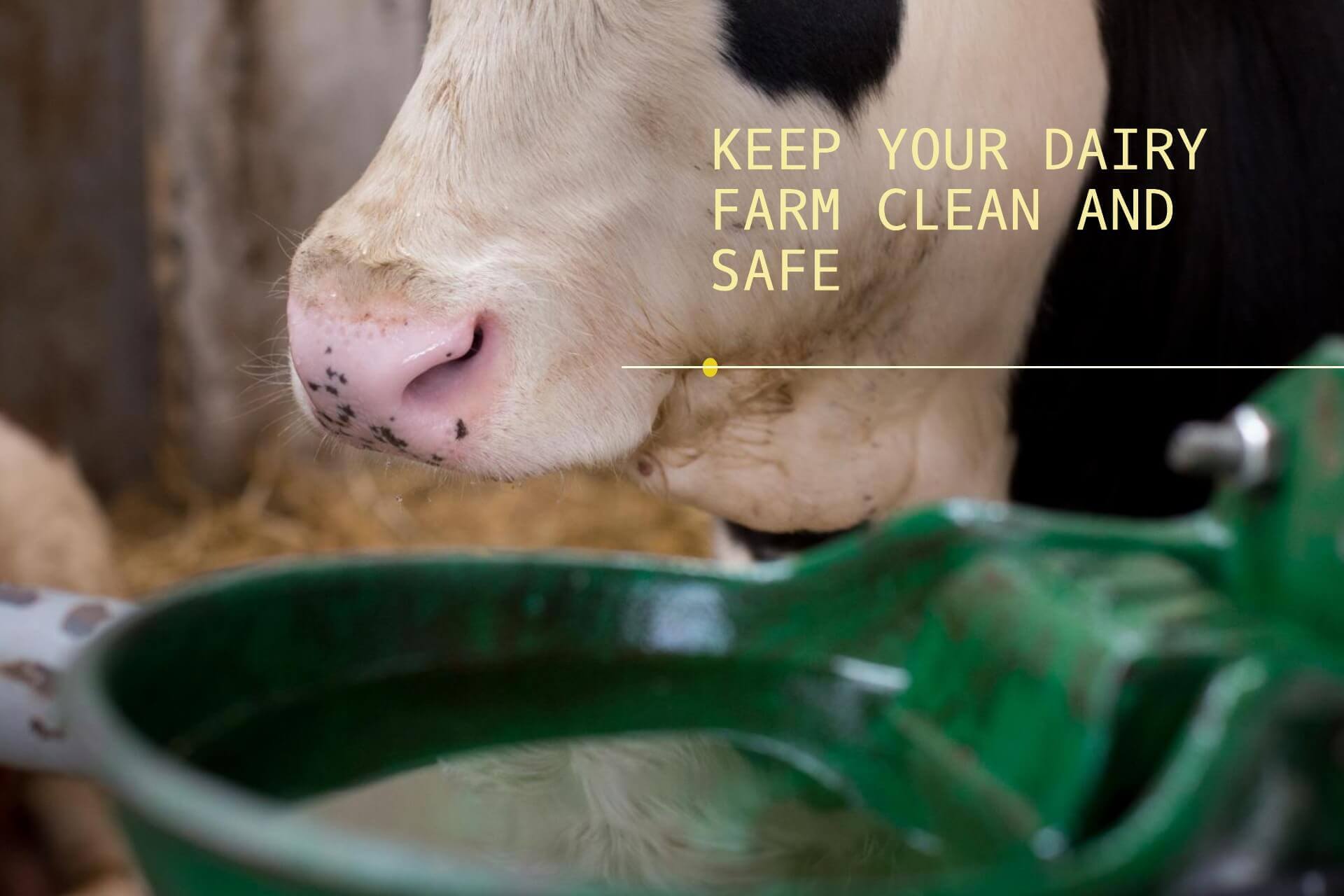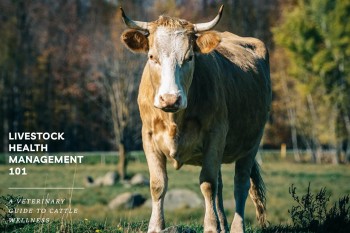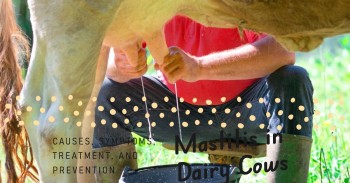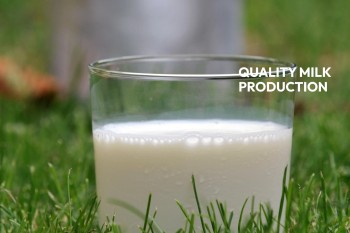Cleaning and Disinfecting on Dairy Farms: A Veterinary Guide
Keeping dairy farms clean is one of the most important things dairy farmers can do to keep their cows healthy and productive. Proper cleaning and disinfection helps prevent the spread of disease-causing bacteria, viruses, and other pathogens that can make cows sick. As a veterinary professional working with dairy farms, I often get asked about best practices for cleaning and disinfecting different areas of the dairy barn and equipment. In this comprehensive guide, I'll share my top tips and recommendations for effective cleaning protocols on dairy farms.
Why Cleaning and Disinfection Matters
Cleanliness is crucial in a dairy operation for many reasons:
Prevents mastitis - Mastitis is the most common and costly disease affecting dairy cows. It's caused by bacterial infections and inflammation in the udder. Keeping the cow's environment, especially bedding, clean is key to preventing mastitis.
Controls spread of pathogens - Salmonella, E. coli, Johne's disease, and other pathogens can quickly spread in unclean barns. Disinfection kills these harmful bugs.
Maintains milk quality - Bacteria and residues can contaminate milk if equipment isn't properly cleaned. Cleaning maintains milk quality.
Promotes overall cow health - Cleanliness reduces exposure to bacteria, viruses, parasites and other sources of infection. Healthier cows are more productive cows.
Prevents infections in calves - Newborn calves are highly susceptible to scours and other illnesses caused by unsanitary conditions.
It's required - Most states mandate dairy farms maintain cleanliness standards. It's not just good practice, it's the law.
Bottom line: Cleaning and disinfection is a cornerstone of dairy farm management and cow health. Doing it properly takes diligence but pays off in the long run.
Developing a Cleaning and Disinfection Protocol
Every dairy should have a written protocol for cleaning and disinfection. This provides clear instructions for all employees to follow. It designates what gets cleaned, how, with what products, and how often.
Here are some tips for developing a protocol:
Involve the veterinarian - I recommend collaborating with your herd veterinarian to develop cleaning procedures that met your farm's specific needs.
Review product labels - Choose cleaners and disinfectants approved for dairy use. Follow label directions on concentration, contact time, etc.
Designate responsibilities - Make sure all staff members know their cleaning duties and schedules.
Establish procedures - Spell out step-by-step cleaning and disinfecting instructions for each area and task.
Train employees - Educate all staff on the importance of proper cleaning and the protocol.
Audit and adjust - Periodically review the protocol and make improvements. Re-train employees as needed.
Having a solid, documented cleaning and disinfection protocol provides consistency while allowing flexibility to adapt as the dairy's needs change. Reviewing it annually with the veterinary team helps ensure it remains current and effective.
Facilities To Clean and Disinfect
Numerous areas on a dairy farm warrant cleaning and disinfection. Here are some of the key facilities:
Milking Parlor
The milking parlor should be cleaned and sanitized both before milking starts and after it finishes. Target these main areas in the parlor:
Floors - Sweep then wash with detergent. Use a disinfectant after each milking.
Walls, windows, lights - Wash manually or with pressure washer. Disinfect weekly.
Equipment - Take apart, wash, rinse, sanitize, and air dry all parts daily.
Bulk tank - Clean after each milk pickup. Clean valves, gauges and agitators thoroughly.
Milk lines - Flush with cold water, circulate cleaning solutions, flush again. Disinfect weekly.
Holding pen - Remove manure daily. Scrub and disinfect walls, floors, and alleyways.
Milk house - Clean and tidy daily. Disinfect floors, drains, and sinks.
Thorough parlor cleaning removes milk residues that support bacterial growth. Disinfection kills lingering pathogens.
Cow Housing Areas
The housing environment can greatly impact udder health and mastitis rates. Focus cleaning efforts here:
Stalls - Remove manure and wet bedding daily. Clean with pressurized water weekly. Disinfect stalls between cow rotations.
Alleys - Scrape manure 2+ times daily. Wash and disinfect floors after scraping.
Walls, partitions - Pressure wash monthly. Disinfect as needed if disease outbreak occurs.
Water troughs - Scrub and disinfect weekly, or more often if visibly dirty.
Feed bunks - Remove old feed daily. Clean and disinfect weekly or if contaminated by manure.
Bedding - Replace regularly to keep clean and dry. Disinfect mattresses between cows.
Ventilation - Clean fans, ductwork, and filters regularly to promote air quality.
Maintaining clean, dry bedding and housing is key to udder health. Routinely disinfecting surfaces helps control contagious pathogens.
Maternity and Calf Areas
Calves are especially vulnerable to health problems from poor sanitation. Priorities here include:
Calving pens - Remove manure, uneaten feed, and soiled bedding immediately after use. Rinse, scrub, and disinfect floors, walls and any equipment before the next calving.
Calf hutches - Clean hutches between calves with soap and bleach solution. Disinfect feed buckets, waterers, and equipment too.
Bedding - Provide thick layer of clean, absorbent bedding. Replace promptly if wet or soiled.
Milk feeding - Thoroughly clean and sanitize feeding pails, bottles, and nipples after every use.
Waterers - Scrub and disinfect calf water troughs 2-3 times weekly. Avoid contamination with manure.
Ventilation - Ensure adequate air circulation. Clean fans and ductwork routinely.
Keeping the calving and calf areas extremely clean is vital for limiting scours and other calfhood diseases.
Other Common Areas
Other areas that warrant cleaning attention include:
Sick pens - Clean thoroughly between occupants. Use soap and disinfectant on all surfaces. Let dry completely.
Footbaths - Maintain proper concentration of disinfectant solution. Change weekly or when visibly soiled.
Tools, supplies - Disinfect hoof trimming tools, calf bottles, pitchforks, and other implements between each use.
Boots, clothing - Provide coveralls for employees. Ensure they remove manure from boots and clothing before entering clean areas.
Vehicles, trucks - Clean and disinfect tires, wheels, undercarriages after visiting other farms. Don't spread pathogens.
Pest control - Inspect for and treat rodents, insects, and birds which spread disease. Remove bird nests and seal pest entry points.
Attending to these common areas prevents pathogens from spreading via foot traffic, manure, vehicles, or pests.
Cleaning Protocols by Surface Material
Cleaning protocols will differ somewhat based on the type of surfaces involved:
Metal Surfaces
Metal is common in stanchions, pipes, and equipment. Follow this approach:
Remove loose dirt or caked material
Wash with detergent and scrub brush
Rinse thoroughly with water
Apply disinfectant and let sit per label instructions
Rinse again
Allow to fully air dry
Disinfectants effective for metal include chlorhexidine, hydrogen peroxide, quaternary ammonium, iodophors, and chlorine solutions.
Rubber and Plastic
For rubber mats, plastic buckets, and other flexible surfaces:
Wash with warm water and detergent
Use scrub brush to remove residues
Rinse completely
Apply disinfectant compatible with plastic
Let sit for required contact time
Rinse again and let air dry
Avoid disinfectants containing iodine, which can stain plastic. Quats, chlorhexidine, and bleach work well.
Concrete Floors and Walls
Concrete is common in barn floors, walls, and holding pens. Best practices are:
Thoroughly scrape, sweep, or scrape to remove organic matter
Pre-soak dried on debris with warm water
Scrub with detergent using a stiff broom or brush
Rinse well with pressurized water
Apply disinfectant diluted per label
Let stand for required contact time
Final rinse
Look for "clean label" disinfectant products suitable for dairy concrete. Avoid excess residues.
Softer Surfaces
For rubber mats, padded stall beds, and soft bedding:
Remove all bedding and manure right down to the bare surface.
Wash with detergent and scrub by hand or with a stiff broom.
Rinse away detergent residues.
Disinfect according to product label.
Allow surface to fully dry before rebedding.
Take extra effort to rinse disinfectants from porous surfaces to prevent leaving chemical residues in bedding.
Wood Surfaces
Wood found in barns should be sealed to allow thorough cleaning. For wood:
Sweep off loose dirt and discard old bedding
Pre-soak and scrub with a detergent solution
Rinse thoroughly with water
Apply disinfectant according to label instructions for concentration, contact time, etc.
Air dry completely before rebedding
Porosity of wood makes it harder to fully disinfect. Take care to remove organic matter before applying disinfectants.
Tailoring cleaning protocols to each type of building material or surface helps optimize results.
Cleaning Tools and Equipment
Having the right tools makes cleaning chores easier and more effective. Here are some must-have cleaning tools:
Brooms - Stiff brooms for scrubbing floors, walls, mats, and removing bedding
Brushes - Scrub brushes for equipment, buckets, surfaces
Scrapers - Manual or mechanical scrapers to remove manure from alleys
Shovels - For removing soiled bedding and manure
Hoses - Heavy duty hoses for wash down areas
Pressure washer - Electric or gas-powered washer to clean equipment, walls, etc.
Detergents - Brands designed for dairy use
Disinfectants - Products registered by the EPA for use against pathogens
Cleaning gloves - Protect hands from chemicals
Scrub boots - Tall boots worn just for power washing, scrubbing areas
Safety gear - Masks, goggles, coveralls recommended when cleaning
Investing in quality cleaning tools makes the job easier. Store them where they are readily accessible but don't get contaminated.
Best Practices for Cleaning Staff
The right tools are important, but proper practices by cleaning staff are equally essential:
Wear gloves, coveralls, goggles
Start cleaning in the cleanest areas and work towards dirtiest
Remove organic matter - manure, old bedding, etc.
Follow proper protocols for each surface type
Use recommended chemicals and procedures
Allow full contact time for disinfectants
Change cleaning solutions when visibly dirty
Rinse surfaces to remove chemical residues
Let areas dry completely before re-use
Dispose of used bedding/manure appropriately
Clean equipment after use and store properly
Report any protocol concerns or issues
Stressing proper practices for the cleaning staff helps ensure protocols are adhered to consistently. Provide training when new employees are hired.
Disinfectant Options
Many types of disinfectants are approved for use on dairy farms. Common choices include:
Chlorine-based products
Low cost and readily available
Effective cleaner at proper concentration
Potentially corrosive at higher concentrations
Requires correct dilution rate
Iodine products
Broad-spectrum disinfecting ability
May stain surfaces
Typically more expensive
Quaternary ammonium (Quats)
Specifically designed for livestock settings
Non-corrosive
Used in foot baths
Limited effectiveness against some pathogens
Chlorhexidine
Broad germicidal activity but limited cleaning ability
Often found in teat dips and scrubs
Hydrogen Peroxide
Breaks down to water so low residue
Works well for cleaning and disinfection
Can be more expensive
Discuss options with your veterinarian and chemical supplier to choose the best fit. Always follow label directions carefully. Rotate products periodically for maximum effectiveness.
Verifying Efficacy of Disinfectants
It's important to periodically verify that your disinfection protocols are working effectively to kill pathogens. Here are some tips:
Culture swabs - Swab cleaned and disinfected surfaces and submit samples to a lab to look for bacterial growth.
ATP meters - Use adenosine triphosphate (ATP) meters to measure organic residues missed by cleaning. Higher ATP readings indicate greater contamination.
Fluorescent gel - Apply gel to surfaces after disinfection then use UV light to check for remaining organic matter.
Disinfectant test strips - Some products provide test strips to verify correct disinfectant dilution strength.
Milk cultures - Monitor monthly bulk tank cultures for bacteria like Staph aureus that indicate milking hygiene issues.
Mastitis rates - Increased clinical mastitis cases may reflect lapses in cleaning and udder prep.
Consult your veterinarian on the best validation options for your operation. Verifying efficacy provides quality assurance for your protocols.
Automated Cleaning Systems
Many larger dairies utilize automated chemical application systems for efficient, consistent cleaning. These allow customization of different protocols for different areas. Consider installing automated systems for:
Pressure washing - Programmable pressure washers clean consistently compared to manual spraying
Soap injection - Chemical pumps meter and inject exact cleaning solution amounts into wash water
Disinfectant application - Automated foaming systems apply foam disinfectant treatment on walls and ceilings
Cleaning verification - ATP meters built into wands instantly detect cleanliness of surfaces
Automated cleaning systems improve efficiency, enhance documentation, allow remote monitoring, and reduce labor needs. The up-front investment pays off with lower costs long-term in many dairies. Consult with dairy system designers on options tailored to your facilities.
Best Practices for Cleaning Water Supply
An ample supply of clean water is essential for dairy operations. Here are tips for managing water for cleaning:
Test annually - Have water tested for contaminants and mineral content
Treat as needed - Use chlorine, ultraviolet, reverse osmosis, or filtration to improve water quality
Flush lines - Flush water lines to remove biofilm and sediment, especially after facility shutdowns
Backflow prevention - Install backflow preventers on plumbing to avoid contamination entering water system
Hot water - Maintain adequate hot water capacity and temp for cleaning needs
Hose sanitation - Flush hoses between uses to remove residues and bacterial contaminants
Sampling ports - Install sampling ports to easily collect water samples for testing
Records - Document all water test results and treatments applied
Consult with your veterinarian on suggested minimum water quality standards for your dairy's cleaning program. Provide staff training on proper sampling procedures for water testing.
cultural Practices Vs Sanitation Products
Proper practices are just as important as what chemicals you use for optimal sanitation programs. Some key points:
Cleaning first - Thoroughly clean surfaces to remove dirt and residues before applying disinfectants.
Organic matter removal - Disinfectants work best on clean surfaces without manure, bedding, or milk residues.
Contact time - Allow disinfectants to sit the required time to fully inactivate pathogens. Don't wipe or rinse off too soon.
Concentration - Follow label directions carefully for diluting chemicals to recommended strengths.
Rotation - Rotate disinfectant classes periodically to prevent pathogen resistance.
Drying - Let surfaces fully dry between uses. Bacteria thrive in moisture.
Sampling - Culture swab high touch areas to verify cleanliness. Identify problem spots.
The right products used incorrectly won't provide adequate disinfection. Training and oversight of staff is equally crucial.
Potential Hazards of Chemicals
While essential, cleaners and disinfectants also present potential health and safety risks:
Chemical hazards
Skin/eye burns - corrosive cleaners can cause chemical burns if splashed on skin or eyes
Toxicity - Some chemicals may cause poisoning if ingested or absorbed through skin
Physical hazards
Slips - Wet floors are slippery, risking falls and injuries
Fire - Flammable cleaning agents can ignite if improperly handled
Environmental hazards
Water contamination - Chemicals must be disposed of carefully to avoid polluting waterways
Pest resistance - Overuse of disinfectants can breed resistant pathogens
Residue buildup - Excess disinfectants left on surfaces risk contaminating milk or feed
To mitigate risks when using chemicals:
Carefully read product labels and Safety Data Sheets
Follow all safety precautions and PPE recommendations
Use proper ventilation in cleaning areas
Mix solutions in well-ventilated areas
Use recommended concentrations - don't overapply chemicals
Store in secure, locked locations inaccessible to children
Train all employees on safe chemical handling
Provide chemical-resistant gloves, goggles, coveralls
Have eye-wash stations and first aid supplies available
Use squeegees to dry floors fast after washing
Dispose of waste properly - don't pour down drains
Rotate disinfectants periodically to avoid resistance
Thoroughly rinse surfaces after disinfecting
Making worker safety a priority when developing cleaning protocols minimizes risks of chemical hazards. Providing proper PPE, training, tools, and facilities demonstrates a commitment to safety.
Documentation and Recordkeeping
Written documentation should accompany all cleaning and disinfection programs. Records to maintain include:
Cleaning protocols detailing each process and responsibility
Product information sheets for all detergents and disinfectants used
Safety Data Sheets for all chemicals onsite
Water test results
Employee training records
Cleaning schedules showing when tasks are completed
Monitoring results (ATP swabs, milk cultures, etc)
Any deviations from standard procedures
Thorough documentation provides better oversight of cleaning programs. The ability to review records builds accountability. Keeping records for at least a year aids troubleshooting of any issues that arise.
Assessing Cleaning Program Effectiveness
Here are some metrics to assess if your cleaning and disinfection program is achieving the desired results:
Reduced clinical mastitis - Quarterly rate should be below 5% of lactating herd
Lower bulk tank SCC - Should average below 200,000 cells/mL
No pathogen growth on cultures - Swabs should show facilities are free of contagious organisms
Visibly clean - All surfaces should be free of manure, milk residue, algae, etc
Dry bedding - Proper dry matter content in beds. Not damp or smearing.
Good hygiene scores - Regular inspections should show exemplary hygiene.
Negative antibiotic residues - No violative antibiotic residues making it into bulk tank
Lower somatic cell counts - SCCs decline in early lactation cows
Higher milk production - Clean environments reduce stress and promote better cow performance
Regular benchmarking provides confirmation that protocols are effective or flags where adjustments may be needed. Reviewing performance metrics with your veterinary team is recommended.
Partnering with Your Veterinarian
Veterinarians can provide invaluable guidance when developing cleaning plans for dairy farms. Your vet can:
Conduct risk assessments to identify high priority areas
Review current protocols and recommend improvements
Suggest disinfectants best suited for your facility
Provide staff training on cleaning procedures
Perform environmental sampling and testing
Interpret results of milk or tissue cultures
Monitor herd health metrics tied to sanitation
Stay current on research and new products
Help diagnose issues if sanitation breaks down
Every dairy benefits from having a veterinary advisor engaged on their sanitation team. My office would be happy to assist in elevating your cleaning and disinfection game.
Effective cleaning and disinfection practices are a foundational biosecurity measure on every dairy farm. Developing comprehensive, documented protocols for each area of the facility ensures consistency. Investing in quality tools, automated systems, and water treatment optimizes efficiency. But proper techniques by trained staff are equally important. Achieving excellent hygiene takes continuous effort and vigilance, but pays off in herd health. I encourage reviewing cleaning protocols annually with your veterinary advisor to confirm they are up to date and working as intended. Consistent sanitation is central to producing high quality milk and keeping cows healthy and productive.

















